What’s inside this article: A look at the least known sensory system, the interoceptive system. This article covers what interoception is, how interoceptive awareness works, the impact this has on emotional self-regulation, signs of modulation challenges, and activities to improve interoceptive awareness.
Disclaimer: This post contains affiliate links.

The interoceptive system is the least known and least understood sensory system.
Interoception is basically the sense of our bodies’ internal state. It’s how we feel and understand what’s happening inside ourselves.
The interoceptive system also controls autonomic motor movements. That is our unconscious movements such as blinking, breathing, flinching, etc.
Find Information About the Other Sensory Systems Here:
- Introduction – The Sensory Spectrum
- The Tactile System
- The Auditory System
- The Visual System
- Proprioception
- Vestibular System
- Interoception
- The Olfactory System
- The Oral-Motor System
- Bilateral Coordination
Interoception
The interoceptive system and our interoceptive awareness are how we recognize internal sensations, like:
- hunger
- thirst
- itch
- needing to use the washroom
- our emotions
Sensory processing differences related to the interoceptive system may cause significant challenges for children.
Not only does this impact their understanding of what’s happening inside their bodies – but it also severely impacts emotions and how to identify emotions.
How Does the Interoceptive System Work?
Although the interoceptive system is not completely understood, what we know is — sensory receptors (about 90% of these are free nerve endings) throughout the body located in the muscles, organs, bones, joints, etc, send neural signals to the insular cortex located deep in the brain.
The insular cortex processes and decodes these messages and then alerts us to any changes in our body’s internal state.
This area of our brain also plays a role in multimodal sensory processing, autonomic control, perceptual self-awareness, and emotional guidance of social behavior. It also helps regulate the sympathetic (fight or flight instinct) and parasympathetic (relaxation response) systems.
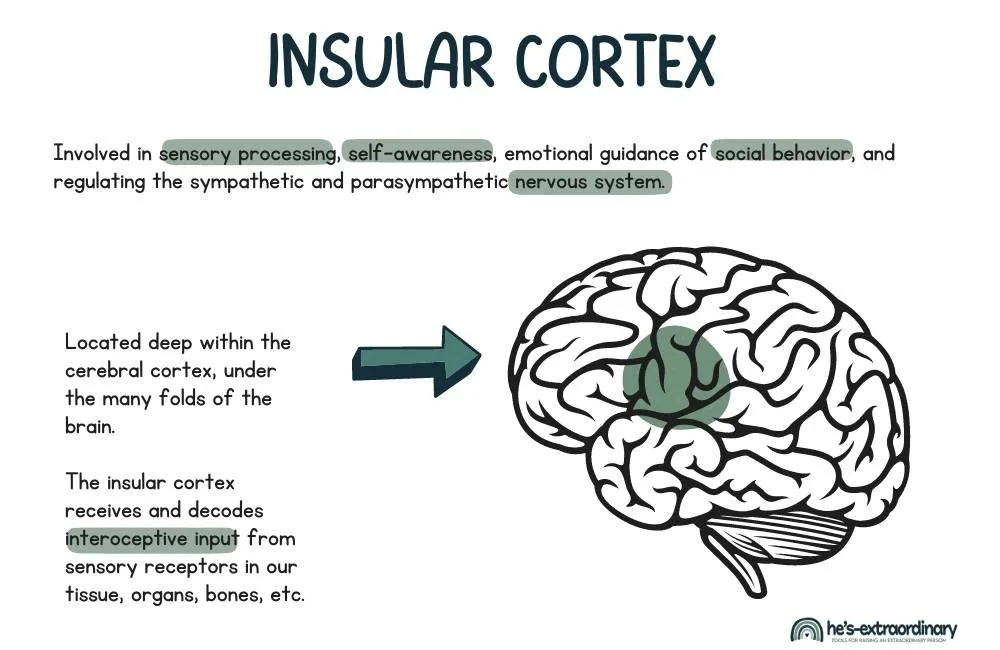
This also allows us to feel emotions – because our various emotional states cause different sensations inside the body which are decoded and allow us to understand how we’re feeling.
Different emotions produce different feelings inside our bodies – this is how we distinguish how we feel.
The Interoceptive System Affects:
- Self-awareness
- Problem-solving
- Perspective-taking
- Social understanding
- Flexible thinking
- Intuition
- Emotional recognition and regulation
Interoceptive Awareness
If I asked you right now, how you feel inside your body, could you tell me?
Is your heart beating fast or slow? Are you tense and sore? Do you need to use the washroom?
You’re able to answer these questions because you have interoceptive awareness.
Children with ASD, SPD, or ADHD may not recognize these sensations in a typical way.
Current research suggests that individuals with autism have much lower levels of interoceptive awareness compared to neurotypical peers.
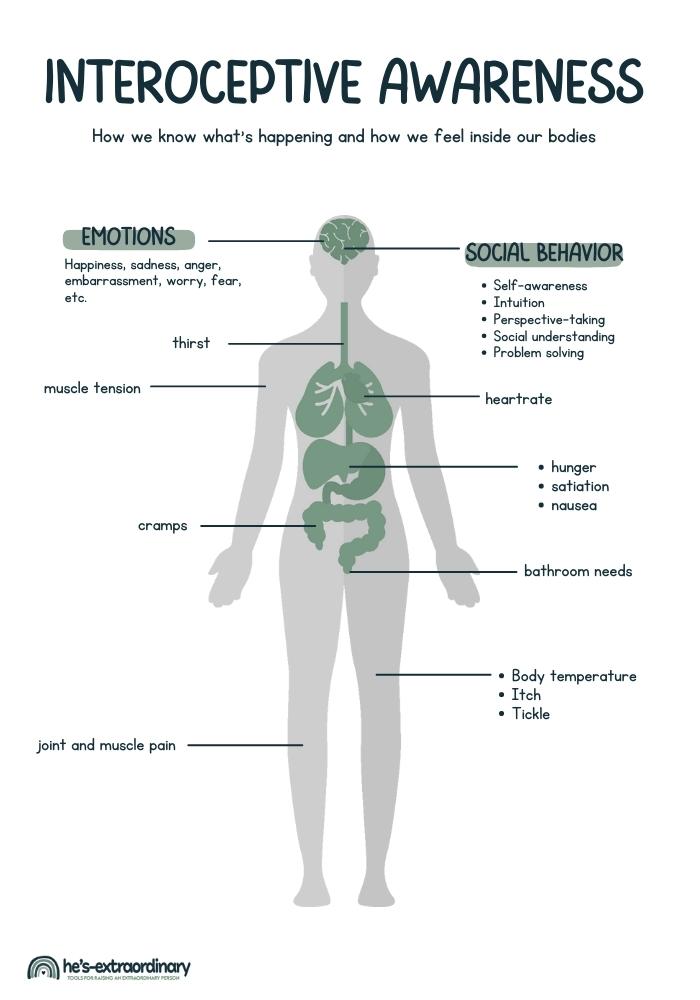
Use the link below to open the PDF poster of the diagram shown above. You can save it to your device to use/print as part of your teaching material. Opens in a new tab, poster dimensions are 18×24, you can resize by selecting “fit to page” when printing.
Current research suggests that most children with autism struggle with hyposensitivity to interoceptive input. However, hypersensitivity is possible, too. Your child may even struggle with both.
Some children with autism have a heightened awareness of internal cues that most of us filter out (like our heart rate and breathing), which can interfere with their ability to pay attention to important sensory input.
How Does Interoception Affect Emotional Regulation?
Does your child struggle with emotional regulation or identifying emotions? Are they able to tell you what they are feeling?
Every emotion that we feel has a corresponding sensation in the body. The sensations can vary from person to person but there are general similarities experienced by most of us.
When you are angry, your heart rate may increase and your face might feel warm.
If you’re nervous, you get butterflies in your stomach.
When you’re sad, your heart may literally hurt, and you may lose your appetite.
However, it is that your body responds – you are able to recognize your emotions intuitively.
If your child lacks interoceptive awareness, it will be more difficult for them to recognize their emotions. Basically, they can’t make the connection between their body sensations and their emotions.
Consider This:
We know that feeling angry causes your heart to race. Fear also causes your heart to race. But – we also have other physical reactions to those emotions, which is why we are able to tell the difference between them.
If your child has poor interoceptive awareness, they may notice only the heart racing, and miss those other cues in their bodies. Then – they may react with anger in situations where that emotion doesn’t fit – and it’s because they can’t tell what they’re feeling.
Interoceptive Awareness & Meeting Basic Needs
How does interoceptive awareness affect the ability to meet our basic needs?
It’s simple for us. If you are hungry – you eat. When you feel full – you stop eating. When you are thirsty – you get a drink. Tired – go to sleep. Cold – put on a sweater. Warm – take off the sweater.
Our interoceptive awareness tells us that something is off inside our bodies and we seek a solution. However, someone with autism may not recognize these cues from the interoceptive system.
For example, some children appear to have extremely high pain tolerance, or they need to be reminded to eat; others can’t tell when they feel full.
For this reason, if your child struggles with self-regulation and you see they are becoming dysregulated and inappropriate behaviors are escalating but you aren’t sure why first consider internal discomfort and basic needs
Maslow’s Hierarchy of Needs
Maslow’s Hierarchy of Needs states that in order for the needs at the top of the pyramid to be met, we must first fulfill the needs at the bottom. Therefore, in order for our kids to reach their full potential, we need their other, more basic needs to be met first.
This is important and applicable throughout life – but for children, in school especially. If your child is in school, and they are hungry, tired, sick, in pain, etc., and their interoceptive awareness is not integrated well enough for them to communicate those needs, they won’t be learning at their true potential.
This is why when behavior is escalating, or there are cues your child may have a meltdown, we need to consider all these factors, including internal needs and the external environment, in order to prevent meltdowns.
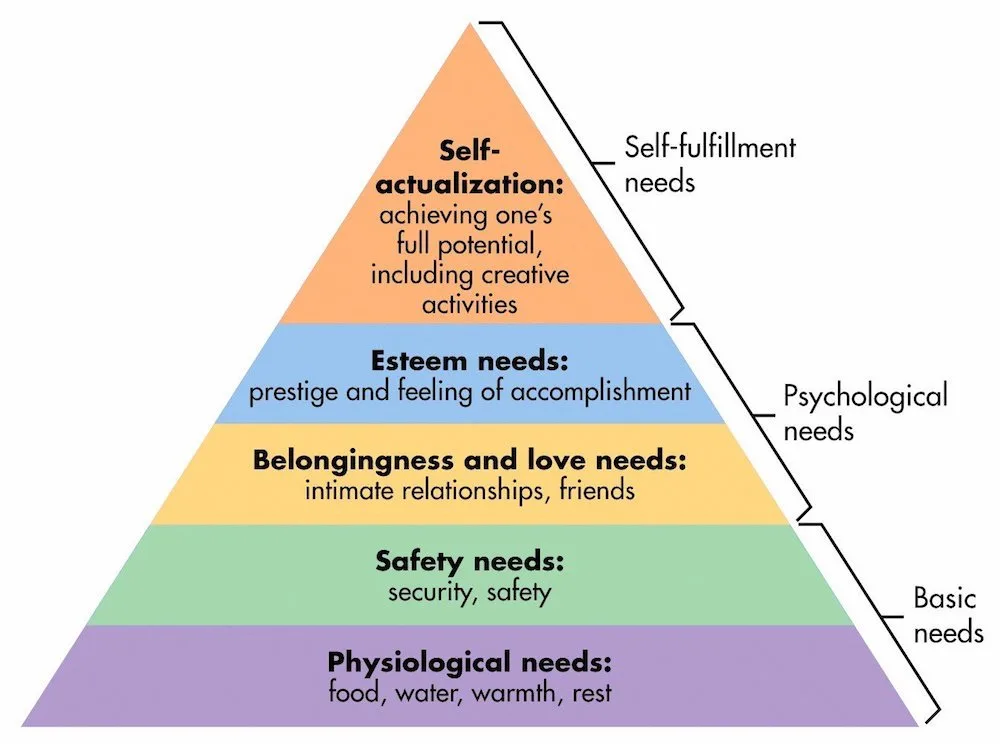
What Else Is Affected By Interoception?
In addition to emotions and self-regulation, interoception affects other executive functions, too:
Poor interoceptive awareness may also explain why potty training is such a common challenge.
It’s the reason why your child may be completely fine one minute and then scream that they are hungry and need to eat “right now!” the next minute.
It’s likely they aren’t aware of those bodily sensations until they become urgent.
Signs Your Child Is Struggling With Interoception
Modulation Issues
This occurs when the brain over- or under-responds to sensory input. With Interoception, over or under-responsiveness can be caused by either:
- The strength of the neural signal – stronger or weaker than typical
- The way the brain perceives the signal
Over-Responsive (Hypersensitive)
- Intense reactions to hunger or needing to use the bathroom. They may even describe hunger as being painful.
- Struggles with focus and attention (because they’re preoccupied with internal stimuli)
- Extreme anxiety over minor dilemmas
- Frequently feels nauseous
- Uses the washroom frequently, unexplained by another medical condition
Under-Responsive (Hyposensitive)
- Extremely high pain tolerance
- Late toilet training
- Doesn’t feel when they need the washroom – accidents and/or constipation
- Doesn’t feel hungry
- Can’t tell when they are full after eating
- May not react to being hot or cold
How to Improve Interoceptive Awareness
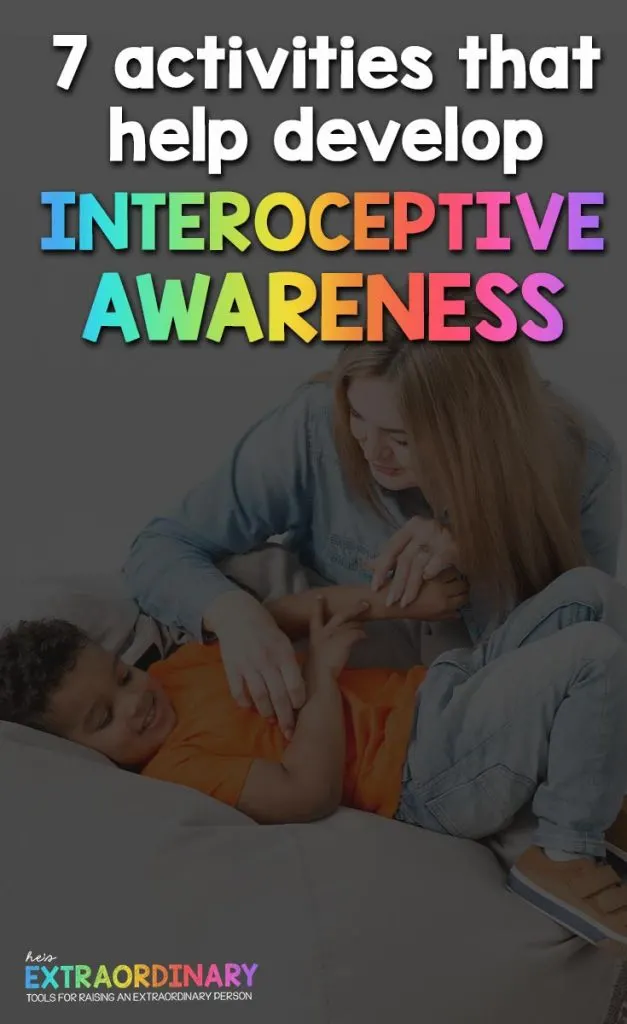
Interoceptive awareness is measured using the Multidimensional Assessment of Interoceptive Awareness (MAIA).
Mental exercises are also used for targeting and improving IA. Studies show that body scans and breathing exercises, common in mindfulness practices, improve interoceptive awareness when done daily.
Research on strategies to help kids with over-responsiveness to interoceptive input is very scarce.
However, mindfulness activities may help children develop a better understanding of their bodily sensations and what they mean. This may help take some of the “urgency” out of these intense sensations.
An occupational therapist can help improve interoceptive awareness by providing specific sensory input to increase your child’s self-awareness.
Body Check
We did this activity with my younger kids. You can read about everything we did how it went, and check out pictures: Identifying Emotions with a Body Check Activity
Older children:
Begin this process with positive experiences like after running around outside, after a warm shower, after a meal, etc.
- Lay out a large roll of paper on the floor. Get your child to lay on
it, then draw an outline of them. - Label specific parts: head, eyes, ears, mouth, voice, chest, heart, hands, stomach, feet, skin, muscles, etc.
- Have the child label one body part and how it feels at that moment (i.e. eyes-sleepy, awake, watery, itchy, dry, etc).
- Continue adding body parts and corresponding sensations, depending on your child’s abilities
- After noticing the sensations of various body parts, give each sensation meaning. For example:
- When your eyes are watery/itchy, it means you are tired
- If your heart is beating fast, you may feel nervous or angry about something
- when your stomach makes a grumbly noise, it means you are hungry
- As the child continues to progress, have them match different body states or emotions to their specific body sensations. (i.e., Nervous: hands sweaty, heart racing, legs moving, stomach fluttery)
Younger children:
- Trace their body on a large piece of paper. Then, point to a body part on the drawing and have them wiggle it on their own body to build body awareness.
- Play a game of Simon Says to build awareness. Use actions like “touch your heart”, “clench your fists”, “breathe really fast.”
- During a body state/emotion, label the body sensations you see in a non-judgmental way (your hands are wiggling, you are breathing fast) and write them on the drawn body.
This will help bring about awareness of their sense of self and begin to understand their body’s signals.
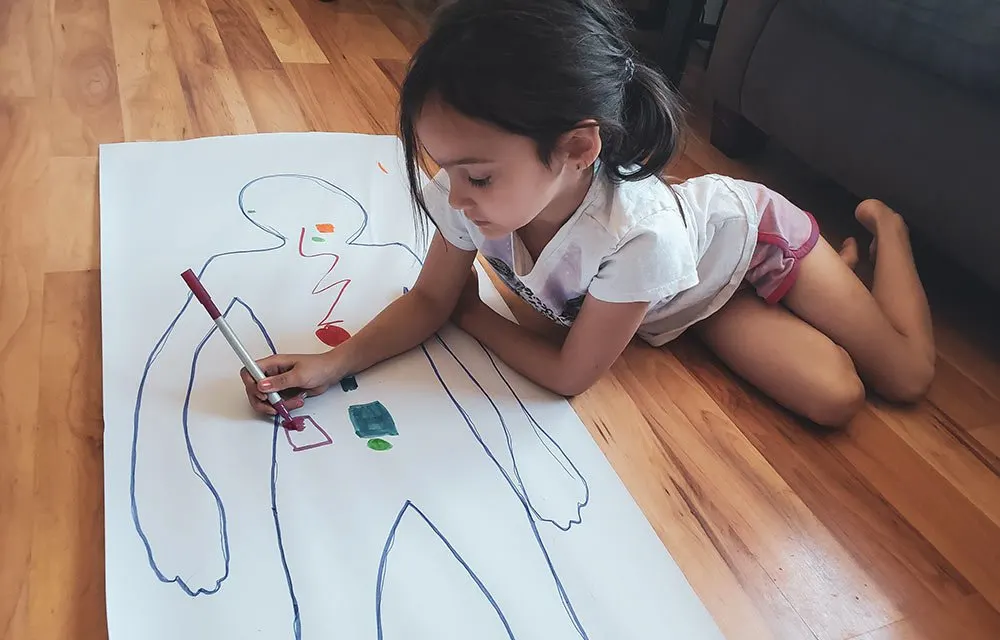
Mapping Feelings
You can also use this printable activity to build body awareness. Print out several copies and get your child to color it in at different times to show what they are feeling.
For example, if they are angry, they may color their hands and head red, and draw their heart to show it’s beating really fast. If they are scared they may color lines in their belly to show its worried and their knees to show they feel weak.
This worksheet can help children notice patterns between their body sensations and their emotions over time, which will help them better identify their feelings.
Mapping FeelingsIf your child becomes dysregulated talking about their emotions…
Some children do get really upset when you try to discuss their emotions with them. It kind of feels like you’re putting them in the hot seat and shining a spotlight on them.
If this is your child, try this instead:
Instead of saying “How does your body feel when you’re mad?”
Try using a hypothetical situation. For example, “Sam’s sister wouldn’t share her play-doh with him. This made him so mad! Can you draw where in Sam’s body he might have mad feelings?”
Essential Oils
Some research suggests copaiba oil improves interoceptive awareness.
For example, a
Alternatively, massaging a single drop into the lower abdomen before bed may reduce bedwetting (another common problem with less interoceptive awareness). You can find more information about essential oils here.
Other Interoception Tips
- Teach children to apply gentle pressure to their lower abdomen to help them feel if their bladder is full.
- Verbally label what your child is feeling for them. For example, “I see you are crying, you must be feeling sad.”
- Consider internal issues as a cause of behavior issues – Ask yourself how long it has been since your child ate, had a drink, is dressed appropriately for the weather, etc.
Additional Reading:
Interoception: The Eighth Sensory System By Kelly Mahler is available on Amazon.
This book provides a detailed description of the connection between interoception and the common experiences of autistic individuals.
The book also includes practical strategies for improving interoceptive awareness and self-regulation.

Sysqoindia
Wednesday 2nd of October 2019
I have been browsing online more than 4 hours today, yet I never found any interesting article like yours. It is pretty worth enough for me. In my opinion, if all site owners and bloggers made good content as you did, the web will be much more useful than ever before.